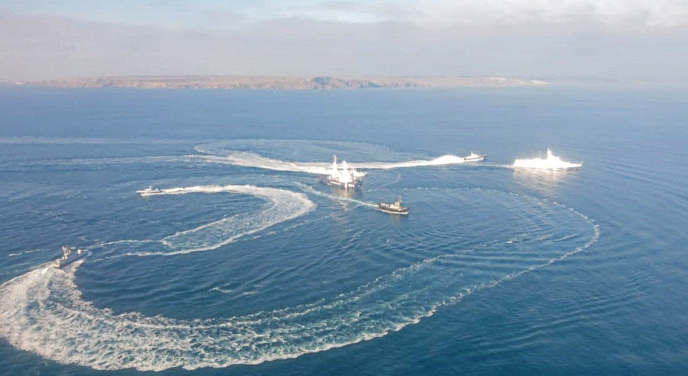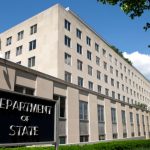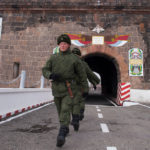- 27 November, 2018
- Democracy and Human Rights

Tensions between Russia and Ukraine may further increase Russia’s isolation after the November 25 incident in Kerch Strait. At the same time, over a short run, the incident will allow Russia to solve some internal issues, as well as to create a certain chaos in Ukraine in relation to the upcoming spring elections in the country.
Where did the incident take place?
After annexation of Crimea, Russia initiated the construction of a bridge connecting the peninsula with the continental part of Russia and passing through the Kerch Strait. After the construction of the bridge, the already limited water area which Ukraine could use for its ship traffic from its Black Sea ports to the ports of Azov Sea, became even narrower and in practice fully appeared under Russian control. In fact, during the incident, the Russian side closed the sea route joining the Black and the Azov seas and did not allow the three Ukrainian ships that had left the port of Odessa to move towards the port of Mariupol in the Azov Sea.
What happened?
According to the Ukrainian side, they had informed the Russian side about the movement of the ships in advance, and had stated that they have the right to do so under the UN Law of the Sea. However, the Russian side stated that Ukrainian ships violated its maritime boundaries. As a result, a collision took place. One of the Russian ships struck one of the Ukrainian ships, then opened fire on the others and captured them. As a result of the collision, six crew members of the Ukrainian ships were injured, the ships and crew were transported to the Kerch port.
After the incident, on November 26, Ukrainian President Petro Poroshenko signed a decree on declaring a 30-day martial law in the country according to which partial mobilization, intensification of security and diplomatic services are planned.
In the evening of November 26, an extraordinary session of the UN Security Council was also convened.
How does the international community respond?
On the day of the incident, Spokesperson for EU Foreign Affairs and Security Policy Maja Kocijancic announced that Russia should restore freedom of passage at the Kerch Strait and urged all to act with restraint to deescalate the situation.
In its turn, NATO stated that it supports the territorial integrity and sovereignty of Ukraine and urged Russia not to hamper the entry of Ukrainian ships into ports in the Azov Sea. Leading European countries also responded to the incident.
The French Foreign Ministry said that the incident at Kerch Strait is a result of annexation of Crimea, and the German Foreign Minister stated that the ongoing conflict in eastern Ukraine and Crimea threatens the security of Europe.
In the evening of November 26, US President Donald Trump responded to the incident stating that they do not like what is happening and that they are working in that direction with their European counterparts. The agenda introduced by Russia, according to which Ukraine violated the Russian maritime boundary, failed at the session of the UN Security Council. Seven countries voted against and four voted for the agenda. During the SC session, the representatives of the US, UK, France, Poland and Sweden expressed concern that 23 Ukrainian sailors are being kept by the Russian side. However, Deputy to Russia’s Permanent Representative in the UN Security Council Dmitry Polyanski insisted that three of the crew members were representatives of Ukrainian special services and were going to do special provocations.
What is it all for?
After Crimea’s annexation, Ukraine has always needed to reinstate its territorial integrity. The movement of ships from Odessa to Mariupol simply means that Ukraine wanted to show that, despite the Russian control of Kerch Strait, it has the right to access its own harbors.
Blocking access to the Sea of Azov, Russia, in its turn, actually establishes total hegemony on the Azov Sea and makes the Ukrainian side dependent on itself.
Besides, the issue is important for Russia in terms of internal political situation. After the pension reform in Russia, when the retirement age was increased, and, as a result, there was a wave of dissatisfaction, Russia’s President Vladimir Putin’s approval rating started to fall. According to results of a survey conducted by the Russia Public Opinion Research Center, Putin’s approval rating as of October 2018 was only 36.8%, when in the autumn of last year it was 59%.
According to another survey by “Public Opinion” Foundation, Putin’s approval rating as of June-July was 48 percent. Such a low approval rating was recorded in 2013 as well. It is noteworthy that Putin’s approval rating started to rise since 2014 and reached its peak in 2015 (75%). That is to say, Putin’s approval rating started to rise against the backdrop of the Russian-Ukrainian conflict and was consolidated after the annexation of Crimea.
Now that dissatisfaction with the pension system has grown in Russia, we cannot not rule out the possibility that the clashes in the Kerch Strait, and subsequent developments will be used to bring Putin’s approval rating up, representing the events as heroic and historic actions.
Besides, no less important is the circumstance that presidential elections are expected in Ukraine in spring, and such an incident, as well as the declared martial law, can lead to political crises in Ukraine and weaken Kyiv’s positions in the settlement of Donbass and Crimea issues.
Vahe Ghukasyan
“Union of Informed Citizens”




